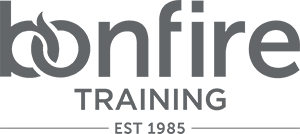How and When to Include Self-Paced Customer Service Training in Employee Onboarding
Building a strong foundation is not just what home improvement stores sell—it’s how they sell it. From zones that mirror the construction process to experts strategically placed at key decision points, nothing about your local Lowes or Home Depot is left to chance. Each section serves a purpose, guiding customers seamlessly from essential materials to specialized support to finishing touches.
Smart HR leaders and trainers apply the same level of strategy to onboarding, especially when faced with a remote or hybrid team. Just as a store layout ensures customers find what they need at the right time, an effective onboarding program delivers training in a structured, step-by-step approach. Self-paced learning formats—like on-demand modules—play a critical role in this process, introducing foundational customer service skills early while allowing new employees to learn at their own pace before applying them in real-world scenarios.
This guide outlines when and how to introduce flexible training formats during and after onboarding, ensuring employees develop strong service skills while continuously improving over time.
When Should Customer Service Training Happen?
Training is most effective when introduced in phases. The right training format at the right time allows new employees to absorb and apply knowledge effectively.
Early Onboarding: Culture & Core Principles
The moment a new employee starts—before they can start working with customers—they need to understand where they are, what’s expected, and how everything connects. As employees become more comfortable with systems and logistics, introducing soft skills training just before go-live ensures better retention and application.
In the first phase of onboarding, customer service training should focus on:
- Introducing company mission, values and service philosophy
- Explaining how customer interactions impact the business
- Providing an overview of key customer service principles
Picture This: A regional utility company is onboarding new customer service representatives responsible for billing inquiries and outage reports. To prevent information overload, the company provides short and engaging learning modules covering company values, customer service philosophy, and expectations. Employees complete these modules at their own pace. This reinforces foundational concepts before live training begins. When they transition to hands-on training, they already understand their role in the customer experience, making later learning more effective.
Late Onboarding: Hands-On Training & Mentorship
Once employees understand the basics, they need practical experience. The best time to introduce soft skills training—such as voice tone, call greetings, transfers, and handling customer interactions—is in the final week before employees go live. At this stage, they are better prepared to retain and apply what they learn.
Self-directed learning plays a key role in preparing employees for this phase, particularly for remote or hybrid teams. By providing structured, self-paced modules on foundational customer service skills, companies ensure new employees engage with key concepts before applying them in live practice.
Training can be used to:
- Introduce common customer interaction scenarios before customer simulations
- Provide brief, digestible modules on best practices for tone, empathy and active listening
- Allow employees to review training materials on demand, reinforcing learning without adding to their workload
Key elements for this stage:
- Live role-playing exercises and customer interaction simulations, allowing employees to apply what they’ve learned in a controlled setting
- Job shadowing experienced employees to see best practices in action and gain confidence in real-time interactions
- Mentorship programs where new hires receive real-time guidance, helping them refine their skills before engaging with customers
Picture This: A large healthcare network is onboarding patient scheduling coordinators. Instead of overwhelming them with live call training in the first weeks, the organization delays soft skills training until the final week before go-live. During this time, employees complete interactive training modules covering active listening, patient communication best practices, and common scheduling challenges. By blending virtual learning with live role-playing exercises and job shadowing, the hospital network ensures employees build confidence and refine their approach before handling real patient interactions.
Month 1-3: Reinforcement & Coaching
After initial hands-on training, employees need reinforcements. This stage is where skills become second nature through practice and structured feedback.
Self-timed learning and on-demand tools play a critical role in reinforcing training during this phase. Providing flexible learning resources allow employees to revisit key concepts as they gain real-world experience. This approach helps bridge the gap between formal training and live customer interactions, enabling employees to build confidence and refine their skills without disrupting workflow.
Essential reinforcement strategies:
- Manager check-ins supported by knowledge checks or short assessments
- Microlearning refreshers on specific techniques
- Live coaching that builds on previous training
Picture This: A national telecommunications provider notices that some newly trained customer support agents struggle with call resolution times and handling escalations. Instead of lengthy retraining sessions, managers assign quick microlearning refreshers focused on de-escalation techniques, system navigation, and efficiency tips. Performance data from assessments helps guide live coaching sessions, ensuring employees receive targeted reinforcement without disrupting their workflow. Over time, this blended approach leads to faster resolutions and higher customer satisfaction.
Beyond Onboarding: Ongoing Development
Customer service training continues after onboarding, ensuring employees stay engaged, adaptable, and aligned with evolving business needs.
Maintaining a consistent, scalable training program across teams—especially in remote or hybrid environments—can be a challenge. On-demand modules are essential for providing employees with ongoing access to customer service training without disrupting daily operations.
Key components of ongoing development include:
- Quarterly refresher courses delivered through brief, self-guided content
- Advanced training programs supporting long-term career growth in service roles
- Performance insights captured through brief digital assessments
Picture This: A regional home builder ensures its customer service team stays sharp with quarterly updates on new policies, product updates, and advanced problem-solving techniques. Employees engage with short video lessons and scenario-based simulations while leadership tracks knowledge retention through brief assessments. By embedding ongoing learning into employees’ daily workflow, the company keeps its service team adaptable, engaged, and consistently improving.
How to Align Customer Service Training with Other Onboarding Elements
Embedding Training into Company Culture
Customer service training should not be an isolated activity—it should be woven into company culture so that it becomes second nature to employees across departments and levels.
Self-paced learning supports this by providing employees with ongoing access to training materials that reinforce company values, expectations, and service philosophy. By integrating asynchronous models into onboarding, companies ensure that new hires engage in key concepts at their own pace while still aligning with cultural expectations.
Ways to reinforce this include:
- Embedding short training videos on customer service values into team meetings
- Encouraging leadership to share insights and best practices to reinforce behaviors
- Recognizing and celebrating employees who excel in customer service interactions through online discussion forums or knowledge-sharing platforms
Pairing New Hires with Mentors
Onboarding should include mentors who can provide guidance. Flexible learning pairs well with mentorship by equipping new hires with self-paced resources before, during, and after their mentor interactions. Instead of relying solely on real-time coaching, employees can review recorded mentor insights, revisit training materials, and submit questions at their convenience, making mentorship more structured and effective.
Benefits of mentorship include:
- More meaningful discussions thanks to pre-learning
- A trusted guide for applying skills in context
- Added confidence from just-in-time access to learning materials
Mentorship is most effective when service standards are already in place. A blended mentoring approach ensures that both mentor and new hires are aligned on company-wide expectations before engaging in live coaching. By training employees on established service standards before mentorship begins, companies create a coaching process rooted in clear expectations rather than personal preferences.
Using Job Shadowing to Reinforce Learning
Observing experienced employees handling real customer situations bridges the gap between theory and practice. Integrating on-demand or blended training into job shadowing helps reinforce lessons through structured pre- and post-learning opportunities. Instead of passively observing, new hires can be provided with:
- Pre-shadowing modules introducing key customer interaction techniques, so they know what to look for
- Digital guides or knowledge checks that help track best practices during their observation session
- Post-shadowing discussion boards or self-reflection prompts, allowing them to document takeaways and apply learnings
This blended approach ensures that job shadowing is not just observational but an interactive learning experience, strengthened by reinforcement.
Leveraging a Blended Learning Approach
A mix of training formats ensures employees can learn at their own pace while still gaining hands-on experience. Best practices include:
- Using on-demand learning modules to introduce basic concepts
- Providing interactive workshops and role-playing exercises
- Scheduling ongoing coaching sessions to reinforce skills
For employees who are hesitant about traditional role-playing exercises, an alternative approach—”role-playing for introverts”—can be highly effective. In this model, employees write out responses to customer scenarios rather than acting them out in front of others. This allows the employee to think critically about their approach while avoiding the anxiety of performing in front of a group. By making role-playing more personal and reflective, employees engage more deeply with the material, leading to better retention and real-world application.
Blended learning allows employees to build confidence without information overload, making training more effective.
Structuring Training for Long-Term Success
A well-designed onboarding program is as intentional as a well-planned hardware store —employees should move through training phases in the right order, just as customers move through a store to gather the materials, tools, and expertise they need to complete their project.
By following a structured, phased approach, companies can:
- Introduce company culture and expectations early
- Deliver soft skills training closer to the go-live date for better retention
- Reinforce customer service skills with coaching and refresher training
- Ensure continuous development through long-term learning strategies
A well-organized store layout creates a smooth experience for do-it-yourselfers, improving efficiency and driving sales. A structured onboarding process works the same way—helping employees feel confident, increasing retention, and strengthening customer service quality.
Bonfire Training specializes in building scalable, high-impact onboarding programs that seamlessly integrate asynchronous learning and live training. With expert-designed training solutions tailored to your organization’s needs, we ensure that your employees receive the right training at the right time—equipping them to deliver exceptional service from day one and continuously improving over time.
Ready to transform your onboarding strategy? Contact Bonfire Training today for a free consultation and discover how we can help you build a training foundation that drives long-term success for your in person, remote, or hybrid teams.

